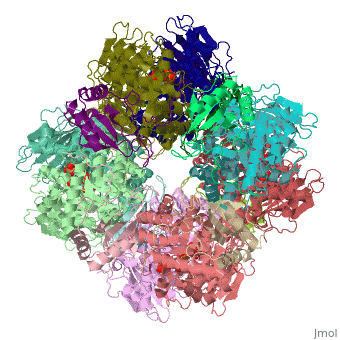|
|
| Line 3: |
Line 3: |
| | <StructureSection load='1rcx' size='340' side='right'caption='[[1rcx]], [[Resolution|resolution]] 2.40Å' scene=''> | | <StructureSection load='1rcx' size='340' side='right'caption='[[1rcx]], [[Resolution|resolution]] 2.40Å' scene=''> |
| | == Structural highlights == | | == Structural highlights == |
| - | <table><tr><td colspan='2'>[[1rcx]] is a 16 chain structure with sequence from [http://en.wikipedia.org/wiki/Spinacia_oleracea Spinacia oleracea]. The November 2000 RCSB PDB [http://pdb.rcsb.org/pdb/static.do?p=education_discussion/molecule_of_the_month/index.html Molecule of the Month] feature on ''Rubisco'' by David S. Goodsell is [http://dx.doi.org/10.2210/rcsb_pdb/mom_2000_11 10.2210/rcsb_pdb/mom_2000_11]. Full crystallographic information is available from [http://oca.weizmann.ac.il/oca-bin/ocashort?id=1RCX OCA]. For a <b>guided tour on the structure components</b> use [http://oca.weizmann.ac.il/oca-docs/fgij/fg.htm?mol=1RCX FirstGlance]. <br> | + | <table><tr><td colspan='2'>[[1rcx]] is a 16 chain structure with sequence from [https://en.wikipedia.org/wiki/Spinacia_oleracea Spinacia oleracea]. The November 2000 RCSB PDB [https://pdb.rcsb.org/pdb/static.do?p=education_discussion/molecule_of_the_month/index.html Molecule of the Month] feature on ''Rubisco'' by David S. Goodsell is [https://dx.doi.org/10.2210/rcsb_pdb/mom_2000_11 10.2210/rcsb_pdb/mom_2000_11]. Full crystallographic information is available from [http://oca.weizmann.ac.il/oca-bin/ocashort?id=1RCX OCA]. For a <b>guided tour on the structure components</b> use [https://proteopedia.org/fgij/fg.htm?mol=1RCX FirstGlance]. <br> |
| - | </td></tr><tr id='ligand'><td class="sblockLbl"><b>[[Ligand|Ligands:]]</b></td><td class="sblockDat"><scene name='pdbligand=RUB:RIBULOSE-1,5-DIPHOSPHATE'>RUB</scene></td></tr> | + | </td></tr><tr id='ligand'><td class="sblockLbl"><b>[[Ligand|Ligands:]]</b></td><td class="sblockDat" id="ligandDat"><scene name='pdbligand=RUB:RIBULOSE-1,5-DIPHOSPHATE'>RUB</scene></td></tr> |
| - | <tr id='activity'><td class="sblockLbl"><b>Activity:</b></td><td class="sblockDat"><span class='plainlinks'>[http://en.wikipedia.org/wiki/Ribulose-bisphosphate_carboxylase Ribulose-bisphosphate carboxylase], with EC number [http://www.brenda-enzymes.info/php/result_flat.php4?ecno=4.1.1.39 4.1.1.39] </span></td></tr> | + | <tr id='activity'><td class="sblockLbl"><b>Activity:</b></td><td class="sblockDat"><span class='plainlinks'>[https://en.wikipedia.org/wiki/Ribulose-bisphosphate_carboxylase Ribulose-bisphosphate carboxylase], with EC number [https://www.brenda-enzymes.info/php/result_flat.php4?ecno=4.1.1.39 4.1.1.39] </span></td></tr> |
| - | <tr id='resources'><td class="sblockLbl"><b>Resources:</b></td><td class="sblockDat"><span class='plainlinks'>[http://oca.weizmann.ac.il/oca-docs/fgij/fg.htm?mol=1rcx FirstGlance], [http://oca.weizmann.ac.il/oca-bin/ocaids?id=1rcx OCA], [http://pdbe.org/1rcx PDBe], [http://www.rcsb.org/pdb/explore.do?structureId=1rcx RCSB], [http://www.ebi.ac.uk/pdbsum/1rcx PDBsum], [http://prosat.h-its.org/prosat/prosatexe?pdbcode=1rcx ProSAT]</span></td></tr> | + | <tr id='resources'><td class="sblockLbl"><b>Resources:</b></td><td class="sblockDat"><span class='plainlinks'>[https://proteopedia.org/fgij/fg.htm?mol=1rcx FirstGlance], [http://oca.weizmann.ac.il/oca-bin/ocaids?id=1rcx OCA], [https://pdbe.org/1rcx PDBe], [https://www.rcsb.org/pdb/explore.do?structureId=1rcx RCSB], [https://www.ebi.ac.uk/pdbsum/1rcx PDBsum], [https://prosat.h-its.org/prosat/prosatexe?pdbcode=1rcx ProSAT]</span></td></tr> |
| | </table> | | </table> |
| | == Function == | | == Function == |
| - | [[http://www.uniprot.org/uniprot/RBL_SPIOL RBL_SPIOL]] RuBisCO catalyzes two reactions: the carboxylation of D-ribulose 1,5-bisphosphate, the primary event in carbon dioxide fixation, as well as the oxidative fragmentation of the pentose substrate in the photorespiration process. Both reactions occur simultaneously and in competition at the same active site.[HAMAP-Rule:MF_01338] [[http://www.uniprot.org/uniprot/RBS1_SPIOL RBS1_SPIOL]] RuBisCO catalyzes two reactions: the carboxylation of D-ribulose 1,5-bisphosphate, the primary event in carbon dioxide fixation, as well as the oxidative fragmentation of the pentose substrate. Both reactions occur simultaneously and in competition at the same active site. | + | [[https://www.uniprot.org/uniprot/RBL_SPIOL RBL_SPIOL]] RuBisCO catalyzes two reactions: the carboxylation of D-ribulose 1,5-bisphosphate, the primary event in carbon dioxide fixation, as well as the oxidative fragmentation of the pentose substrate in the photorespiration process. Both reactions occur simultaneously and in competition at the same active site.[HAMAP-Rule:MF_01338] [[https://www.uniprot.org/uniprot/RBS1_SPIOL RBS1_SPIOL]] RuBisCO catalyzes two reactions: the carboxylation of D-ribulose 1,5-bisphosphate, the primary event in carbon dioxide fixation, as well as the oxidative fragmentation of the pentose substrate. Both reactions occur simultaneously and in competition at the same active site. |
| | == Evolutionary Conservation == | | == Evolutionary Conservation == |
| | [[Image:Consurf_key_small.gif|200px|right]] | | [[Image:Consurf_key_small.gif|200px|right]] |
| Line 32: |
Line 32: |
| | ==See Also== | | ==See Also== |
| | *[[RuBisCO|RuBisCO]] | | *[[RuBisCO|RuBisCO]] |
| | + | *[[RuBisCO 3D structures|RuBisCO 3D structures]] |
| | == References == | | == References == |
| | <references/> | | <references/> |
| Structural highlights
Function
[RBL_SPIOL] RuBisCO catalyzes two reactions: the carboxylation of D-ribulose 1,5-bisphosphate, the primary event in carbon dioxide fixation, as well as the oxidative fragmentation of the pentose substrate in the photorespiration process. Both reactions occur simultaneously and in competition at the same active site.[HAMAP-Rule:MF_01338] [RBS1_SPIOL] RuBisCO catalyzes two reactions: the carboxylation of D-ribulose 1,5-bisphosphate, the primary event in carbon dioxide fixation, as well as the oxidative fragmentation of the pentose substrate. Both reactions occur simultaneously and in competition at the same active site.
Evolutionary Conservation
Check, as determined by ConSurfDB. You may read the explanation of the method and the full data available from ConSurf.
Publication Abstract from PubMed
The three-dimensional structure of the complex of ribulose 1,5-bisphosphate carboxylase/oxygenase (rubisco; EC 4.1.1.39) from spinach with its natural substrate ribulose 1,5-bisphosphate (RuBP) has been determined both under activating and non-activating conditions by X-ray crystallography to a resolution of 2.1 A and 2.4 A, respectively. Under activating conditions, the use of calcium instead of magnesium as the activator metal ion enabled us to trap the substrate in a stable complex for crystallographic analysis. Comparison of the structure of the activated and the non-activated RuBP complexes shows a tighter binding for the substrate in the non-activated form of the enzyme, in line with previous solution studies. In the non-activated complex, the substrate triggers isolation of the active site by inducing movements of flexible loop regions of the catalytic subunits. In contrast, in the activated complex the active site remains partly open, probably awaiting the binding of the gaseous substrate. By inspection of the structures and by comparison with other complexes of the enzyme we were able to identify a network of hydrogen bonds that stabilise a closed active site structure during crucial steps in the reaction. The present structure underlines the central role of the carbamylated lysine 201 in both activation and catalysis, and completes available structural information for our proposal on the mechanism of the enzyme.
The structure of the complex between rubisco and its natural substrate ribulose 1,5-bisphosphate.,Taylor TC, Andersson I J Mol Biol. 1997 Jan 31;265(4):432-44. PMID:9034362[1]
From MEDLINE®/PubMed®, a database of the U.S. National Library of Medicine.
See Also
References
- ↑ Taylor TC, Andersson I. The structure of the complex between rubisco and its natural substrate ribulose 1,5-bisphosphate. J Mol Biol. 1997 Jan 31;265(4):432-44. PMID:9034362 doi:10.1006/jmbi.1996.0738
|


